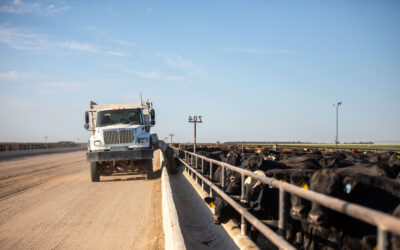
Marbling, Feet and Fertility: Are they related?
A look into the Angus database to see how marbling affects fertility and feet challenges.
by Kara Lee
November 2024
In the more than 15 years of my business travel, the Chicago airport has gained a reputation for canceled and delayed flights more than any other connection. It is easy to blame the city and assert their airports just aren’t reliable. But when looking at the full scenario, it is usually an unrealistic connection time or simply bad weather.
When frustrated, it’s easy to place blame on the circumstances right in front of you—whether in air travel or breeding objectives.
In recent years, Angus breeders have voiced concerns about fertility and feet. Some have looked at the upward trajectory of marbling within the breed and sent up caution flags as selection pressures rise.
Overall, has our breed been so focused on marbling that we’ve lost sight of other valuable traits? Worse yet, has improving the marbling potential of a calf crop contributed to other challenges in the cow herd?
When studying the data, we inherently know correlation does not always mean causation. But it does lead one to wonder about coincidence.
A look into the data
One of the best tools touted by the American Angus Association (Association) membership is its database. Within that, the Angus Herd Improvement Records (AHIR) program offers valuable insights into disposal codes or the primary reasons cattle were removed from a herd.
In search of answers, Certified Angus Beef (CAB) worked alongside the Association team to identify genetic trends between fertility and feet issues and the culled animals’ Marb EPDs. To do this, the Association provided all disposal code records from the AHIR database for both fertility and feet from 2010 through 2023. This data was not limited to breeders participating in whole herd reporting (inventory reporting), so it gives a glimpse of disposal codes from a variety of cow herds.
In both cases, there is a normal distribution of animals culled—indicated by the bell-shaped curve. The real lessons become visible when we draw lines at the marbling threshold for Targeting the Brand™.
For several years, CAB has published Targeting the Brand requirements for Marb EPD and Grid Value Index ($G) to help commercial customers easily identify bulls with added genetic carcass value. The Marb EPD requirement starts at +0.65.

Caption: From 2010 to 2023, more than 72,000 females were culled from the herd due to being open or having other fertility issues. Many culls fall below the black line representing the Targeting the Brand minimum requirement for Marb EPD (+0.65.)

Caption: From 2010 to 2023, more than 7,600 cows, bull, and calves were culled for foot issues. Many culls fall below the black line representing the Targeting the Brand minimum requirement for Marb EPD (+0.65.)
The graphs depict a very clear perspective of where cattle culled for fertility and feet issues fall on the marbling scale. In both cases, most cattle culled fall below the +0.65 threshold. The same is true if you draw that line at the 2024 breed average for current sires (+0.60). Certainly, there are also cattle with very high marbling values culled from their herds due to foot or fertility problems. However, the whole picture shows many of those culled cattle are not considered elite for carcass quality.
In both graphs, the peak of the bell-shaped curve lands around +0.40 for Marb. If you follow Angus genetic trends by birth year, the last time cattle averaged a +.40 for Marb was 2005. Since then, we’ve seen a strong upward trend in average Marb EPD values. Over that same period, CAB acceptance rates have more than doubled as breeders continue to pursue carcass traits, driven by a quality-minded market.
Data-based decision-making
It’s been said that the Angus cow is the unsung hero of the Certified Angus Beef ® brand. Without her ability to perform at the cow-calf level, our industry would not have been able to pursue the long-term improvements to carcass quality we’ve enjoyed for the last 45+ years.
Cattle producers have a responsibility to look critically at their own cow herd and determine the weakest areas that warrant improvement. Fertility should be a high priority. Critical evaluation of foot phenotypes should also be encouraged. Yet, neither of those must come at the cost of marbling potential.
The Angus breed has enough genetic diversity to allow breeders, and their commercial bull customers, to make progress across multiple traits simultaneously. One bloodline may be high in marbling but does not check the boxes you need for other traits. That does not mean marbling is the cause—it simply means your search for the ideal genetic pairing is not done.
Just as I may better evaluate flight schedules for successful connections, Angus breeders should consider all genotypic and phenotypic records for advantageous breeding decisions.
Originally published in the Angus Journal.
You may also like
CAB Sets Sales Records, Sees Historically High Brand Acceptance Rates
In an otherwise tough time in the beef business, sales and supply records have been a bright spot. The positive numbers mean that quality beef production has not let up, and beef demand is holding. Consumers have proven the value proposition: the good stuff is worth a little more money, for a better eating experience.
Feeding Quality Forum Dates Set Earlier in August
When you’re feeding cattle, it counts to keep track of every calf, pound and dollar. Beyond the event’s educational sessions, networking between segments of the beef supply chain is invaluable—from feeders and cow-calf operators to allied industry and university researchers.
Gardiners Highlight Service, Strength at Foodservice Leaders Summit
Mark Gardiner and his son, Cole, of Gardiner Angus Ranch offered a boots-on-the-ground perspective for CAB specialists attending the annual event, designed to deliver resources that help train foodservice teams and serve consumers at a higher level.



